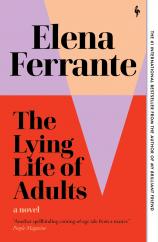Reading Group Guide
Discussion Questions
The Lying Life of Adults

1. In an interview (published in the US by ELLE magazine), Elena Ferrante wrote: “Lenù and Lila [from the Neapolitan Quartet] also try to tear the neighborhood out of themselves, but while they have to laboriously fabricate the tools to help them break free of real and figurative poverty, Giovanna [the protagonist of THE LYING LIFE OF ADULTS] finds those tools at home, ready to be used against the very world that has provided them.” What are the tools that Giovanna finds and uses to distance herself from the milieu in which she is growing up? Does she merely use these “tools,” or does she also fabricate a “self” in order to break free? What, then, is the difference between a fabrication of this kind and mere lies? Who does most of the lying in this novel?
2. Are “adult lies” fundamentally different from the lies children and adolescents tell? Are lies of omission or lies of willful ignorance somehow different from other kinds of lies? What instances of lying are there in the book, and what do these examples illustrate?
3. Giovanna’s crisis of identity, if it can be called such, is provoked by a comment overheard that pertains to her physical appearance. What role do appearances play in this novel, and especially appearance as it relates to class and character?
4. Education played such an important role in the stories of Lenù and Lila (in the Neapolitan Quartet). Does it play as significant a role in THE LYING LIFE OF ADULTS? And, if not, has some other social institution stepped into the role that schooling played in the Neapolitan Quartet?
5. What is it about Vittoria that initially attracts (or repulses) Giovanna? How does her relationship to Vittoria evolve over the course of the book?
6. What agency does Giovanna gain --- or take --- over the course of the novel, especially as a result of her choices at the end of the book? Has Giovanna in some way “reached adulthood” by the end of the novel? What do you think are the true markers of leaving behind adolescence and entering adulthood?
7. “Naples is already part of me, as I am of Naples” (Elena Ferrante). THE LYING LIFE OF ADULTS extends Ferrante’s attempt to create an imaginative portrait of Naples that does justice to its complexity. What do we see of Naples in this book that we haven’t seen before? How does it add to Ferrante’s fresco of the city?
8. Ferrante has said that, of all the male characters in her novels, Enzo, from the Neapolitan novels, is the most positive of them, because, she writes: “I like men who use their strength discreetly to help you live --- without too many words, without sentimentality, without expecting compensation. Real understanding of women seems to me the highest application of the male’s intelligence and capacity for love.” In THE LYING LIFE OF ADULTS, Roberto is the first apparently positive male figure in Giovanna’s life. Is he a positive male character, according to the criteria Ferrante posits above? What role does he play in Giovanna’s life?
9. What do the young men who play a role in Giovanna’s story in this novel --- Corrado, Rosario and Roberto --- have in common? How are they different? How does Giovanna’s reaction to physical intimacy with these men compare/differ to the physical intimacy she shares with Angela and Ida?
10. Giovanna lives in two different worlds as she enters adolescence and adulthood. The world of her parents: high-brow intellectuals, educated, proud, refined; and the world of her aunt: low-brow, uneducated, vulgar, violent. At the start of the novel, you’re meant to believe that the two worlds were purely opposites. But are the two worlds more alike than dislike, and if so, in which ways? Are Vittoria and Andrea similar? How are the neighborhoods that Angela, Ida and Giovanna grew up in similar to where Tonino, Giuliana and Corrado grew up? In turn, what role does sex, in particular, play in uniting the “two Naples”?
11. A significant role is played in this novel by a bracelet. Some have argued that the bracelet is a McGuffin, while others see it as a vital narrative cue in the story, marking off stages in Giovanna’s development as a woman and a character. For you, what is signified by each change of hands of the bracelet? How has its place in the story shaped Giovanna’s view of love, life and adulthood?
12. Jealousy and hypocrisy are underlying currents of emotion throughout the novel, linking all of the characters. How do those emotions inform the characters’ decisions and where they end up?
13. On page 224, Giovanna tells Angela that “Everyone who loves is afraid of not being loved.” Though they are mainly talking about Giuliana, could this quote pertain to other characters in the novel? What role does insecurity play in driving characters’ actions over the course of the novel?
14. Submergence and emergence --- of familial traits, or trauma, of the influence of environmental factors, etc. --- play a determining role in Ferrante’s novels. How do generations of various family dynamics affect Giovanna’s adolescence? How does parental/family drama affect children growing up in it?
15. How does faith/religion intersect with knowledge/education as determining influences on Giovanna’s vision of the world in this novel? Is one more important than the other? Are they interchangeable? Do you think Giovanna comes to understand both in her own way for her own use? Why or why not?
16. “Between twelve and sixteen I eagerly looked for any books that had a woman’s name in the title: MOLL FLANDERS, JANE EYRE, TESS OF THE D’URBERVILLES, EFFI BRIEST, MADAME BOVARY, ANNA KARENINA. But the book I read and reread obsessively was WUTHERING HEIGHTS. Today I still find extraordinary the way it describes love, mixing good and bad feelings without any break” (Elena Ferrante, interview in ELLE). Ferrante has spoken often about the formative influence of other authors on her development as a writer --- from the classics of Greek theater to the great novels of the 19th and 20th century. What echoes of other literary works do you hear in THE LYING LIFE OF ADULTS?
The Lying Life of Adults
- Publication Date: September 21, 2021
- Genres: Fiction, Women's Fiction
- Paperback: 328 pages
- Publisher: Europa Editions
- ISBN-10: 1609457153
- ISBN-13: 9781609457150







